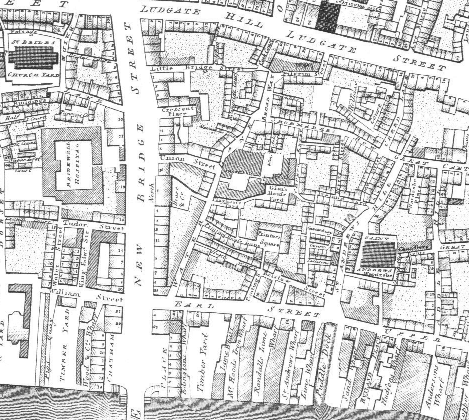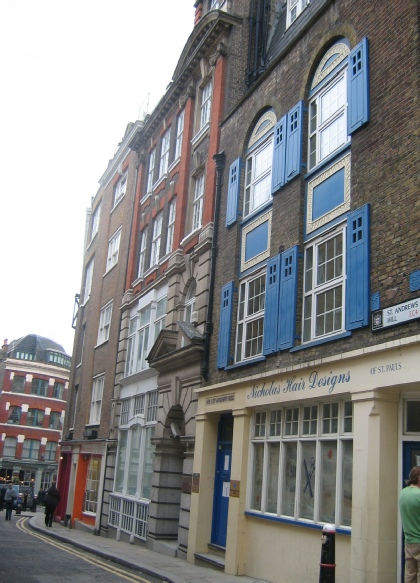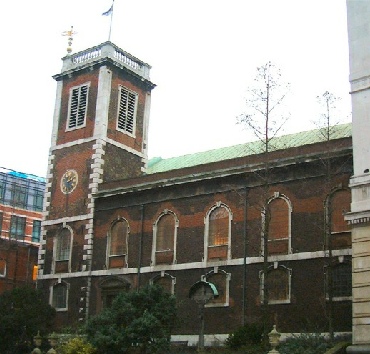



|
|
In 1780-
|
|
|
In 1785-
|
|
|
By 1790-
|
|
|
By 1796-
|
It would have been primarily in St Andrew’s Hill that Walter and Ann’s children grew up – property in this street remained in the family for at least 70 years after this and a number of the houses still exist today: they are tall, narrow and elegant buildings, the tops of which can hardly be seen from the level of the narrow and winding short street.
Professional Life
Bit by bit Walter Newbon built up his business, making a number of shrewd investments, and by the time of his early death in 1798, at the age of only 48, he was a wealthy man. A newspaper report in The Times of 1792 gives a unique picture of him as the only baker in St Andrew’s Hill at this time -
Later years
Walter Newbon’s lengthy will tells us more about his life and his family’s situation. It was drawn up on December 21st 1797, 10 months before Walter’s death. It is possible that he was already ill at this time, although the will does not state this. He left his business, at his home in St Andrew’s Hill, to his widow Ann, with instructions to

There is evidence to suggest that Walter was ill for at least a short while before his death, and possibly for a year or so, if the date of his will is significant. On October 19th 1798, 3 weeks or so before his death, Walter appeared in the court of Chancery as orator (i.e. plaintiff) in a case he brought against a gentleman named Archer Wilson of Fulham. It seems that Walter had lent him a large sum of money for some leasehold property in Marylebone but had not been repaid. Although he was clearly not too ill to appear in court,
It was left to Ann Newbon and her 2 fellow executors to return to Chancery to regain the money owing to Walter, for he died some time in November 1798, and was buried inside the church of St Andrew-
The lives of Walter’s children
All of Walter and Ann’s children married, although none of them in Walter’s lifetime.
|
|
Their eldest daughter Ann married a widower Samuel Thomas Deakin Edge at St Andrew-
|
|
|
Susanna Newbon married John Shelton, later a prominent Southwark businessman, in 1800, a month before the marriage of her elder sister Ann, also at St Andrew-
|
|
|
James Newbon married Jane Cobbett at St Clement Danes on January 18th 1805. His family came to know considerable wealth in the Victorian period. (See the section devoted to the life of James Newbon).
|
|
|
Walter Newbon married Mary White on May 10th 1815 at Christchurch, Newgate Street, although nothing more is known about his life beyond the fact that he became a freeman of the Bakers’ Company in 1801. No trace has been found either of his or of Mary’s burial, nor do they seem to have had children. The fact that he was the first of Walter’s sons to become a member of the Bakers’ Company may indicate that this was important to him professionally. Possibly he followed in his father’s footsteps by becoming a baker, although his name cannot be found in trade directories of the period. His mother’s will makes it clear that he was still alive in 1829.
|
|
|
Sarah Newbon married William Feltham, a Marshalsea court officer, at St Mary’s Church, Lambeth on June 1st 1801, following which the couple settled in Southwark. Two of their three children survived to adulthood. A William Feltham was a neighbour of the Newbons in St Andrew’s Hill, Blackfriars in the 1790s -
|
|
|
Charles Newbon’s marriage to Henrietta Blyde took place at St Bride’s, Fleet Street in 1810. Charles became a relatively wealthy man in his own right, largely through hard work and commitment to his tailor’s business. He is a very important figure in the Newbon family, the ancestor of the vast majority of present-
|
|
|
Benjamin Newbon married Mary Ann Howling at Newington on July 8th 1822. Little is known about Benjamin’s life, beyond the fact that he became a freeman of the Bakers’ Company in 1834, although we are given no indication why he left this relatively late in his life. He is listed on the 1841 census living in Golden Lane, Cripplegate, which is where he died in 1847, 2 years after his wife. His death certificate shows that he was a cabinet-
|
Interestingly, Ann Newbon’s will makes no mention of her daughters-


at the end of the 18th century
|
Born: |
1750 (King’s Cliffe, Northamptonshire) |
Died: |
1798 (Blackfriars) |
|
Father: |
William Newbon (1717- |
Mother: |
Ann Newbon, formerly Swepston (1723- |
|
Spouse: |
Ann Newbon, formerly Dixon (1743- |
Occupation: |
Baker |
|
Children: |
Ann Newbon (1775- Walter Newbon (1780- Benjamin Newbon (1787- |
||
To Top of Page
|
|
|
|
|
|
|
|
|
|
|
|
|
|
|
|
|
|
|
|
|
|
|
|
|
|
|
|
|
|
|
|
|
|
|
|
|
|
|
|
|
William Newbon |
= |
Ann Dixon |
= |
Walter Newbon |
|
|
|
|
|
|
|
|
|
|
|
|
|
|||||||||||
|
|
|
|
|
|
(1737- |
|
|
(c1743- |
|
|
(1750- |
|
|
|
|
|
|
|
|
|
|
|
|
|
|||||||||
|
|
|
|
|
|
|
|
|
|
|
|
|
|
|
|
|
|
|
|
|
|
|
|
|
|
|
|
|
|
|
|
|
|
|
|
|
|
|
|
|
|
|
|
|
|
|
|
|
|
|
|
|
|
|
|
|
|
|
|
|
|
|
|
|
|
|
|
|
|
|
Ann Newbon |
Susannah Newbon |
|
James Newbon |
|
Walter Newbon |
|
Sarah Newbon |
|
Charles Newbon |
|
Benjamin Newbon |
||||||||||||||||||||||
|
(1775- |
(1777- |
|
(1778- |
|
(1780- |
|
(1781- |
|
(1784- |
|
(1787- |
||||||||||||||||||||||
|
= |
= |
|
= |
|
= |
|
= |
|
= |
|
= |
||||||||||||||||||||||
|
Samuel Thomas |
John Shelton |
|
Jane Cobbett |
|
Mary White |
|
William Feltham |
Henrietta |
|
Mary Ann |
|||||||||||||||||||||||
|
Deakin Edge |
|
|
|
|
|
|
(1777- |
|
|
|
|
|
|
(c1777- |
Harriet Blyde |
|
Howling |
||||||||||||||||
|
(1773- |
|
|
|
|
|
|
|
|
|
|
|
|
|
|
|
|
|
|
(c1790- |
|
|
|
|
|
|
||||||||
|
|
|
|
|
|
|
|
|
|
|
|
|
|
|
|
|
|
|
|
|
|
|
|
|
|
|
|
|
|
|
|
|
|
|
|
|
|
|
|
|
|
|
|
|
|
|
|
|
|
|
|
|
|
|
|
|
|
|
|
|
|
|
|
|
|
|
|
|
|
|
Mary Ann Edge |
James |
|
Sarah |
|
Henry |
|
|
4 other |
|
John |
|
Walter |
|
Diana |
|
Henrietta |
5 other |
||||||||||||||||
|
(1803- |
Shelton |
|
Jane |
|
Newbon |
|
|
children |
|
Newbon |
|
Henry |
|
Nancy |
|
Newbon |
children |
||||||||||||||||
|
= |
Newbon |
|
Newbon |
|
(1813- |
|
|
|
|
|
(1813- |
Newbon |
|
Newbon |
(1833- |
|
|||||||||||||||||
|
Charles |
(1806- |
|
(1810- |
= |
|
|
|
|
|
|
= |
(1820- |
(1824- |
|
= |
|
|
||||||||||||||||
|
Meredith |
= |
|
= |
|
Elizabeth |
|
|
3 children |
Ellen |
|
= |
|
= |
|
William |
|
|
||||||||||||||||
|
(c1805- |
Ann |
|
Charles |
|
Shepard |
|
|
|
|
|
Dodds |
|
Ellen |
|
John |
|
Turner |
|
|
||||||||||||||
|
|
|
|
|
Brocklebank |
Crickmer |
|
(1816- |
|
|
|
|
|
|
(1813- |
|
Ann |
|
Edward |
|
(c1825- |
|
|
|||||||||||
|
3 children |
(1813- |
(c1793- |
|
|
|
|
|
|
|
|
|
|
|
Martin |
|
Murray |
|
|
|
|
|
|
|||||||||||
|
|
|
|
|
|
|
|
|
|
|
|
|
|
|
|
|
|
|
|
|
|
(1834- |
(1825- |
|
|
|
|
|
||||||
|
|
|
|
|
|
|
|
|
|
|
|
|
|
|
|
|
|
|
|
|
|
|
|
|
|
|
|
|
|
|
|
|
||
|
|
|
|
|
|
|
|
|
|
|
|
|
|
|
|
|
|
|
|
|
|
|
|
|
|
|
|
|
|
|
|
|
|
|
|
|
|
|
|
|
|
|
|
|
|
|
|
|
|
|
|
|
|
|
|
|
|
|
|
|
|
|
|
|
|
|
|
|
|
|
|
|
|
|
|
|
|
|
|
|
|
|
|
|
|
|
|
|
|
|
|
|
|
|
|
|
|
|
|
|
|
|
|
|
|
Charles |
Joseph |
6 other |
5 children |
5 children |
John |
Charles |
Walter |
Thomas |
4 daughters |
9 children |
|||||||||||||||||||||||
|
Evans |
Newbon |
children |
|
|
|
|
|
|
Joseph |
Henry |
Augustus |
Cary |
|
|
|
|
|
|
|
||||||||||||||
|
Newbon |
(1840- |
|
|
|
|
|
|
|
Newbon |
Newbon |
Newbon |
Newbon |
|
|
|
|
|
|
|
||||||||||||||
|
(1839- |
|
|
|
|
|
|
|
|
|
(1842- |
(1845- |
(1850- |
(1852- |
|
|
|
|
|
|
||||||||||||||

| Site Map |
| Background to my research |
| Background to the surname NEWBON |
| Documents available and sources used |
| Name index |
| Walter Newbon's descendants |
| Northamptonshire Newbons |
| Redbourn, Hertfordshire |
| James Shelton Newbon |
| Henry Newbon |
| The Crickmer family |
| The Newbon Family and the City of London |
| Charles Evans Newbon |
| Joseph Newbon |
| The Brockelbank Family |
| The United Wards' Club of the City of London |
| John Newbon |
| The Children of John Newbon |
| World War I |
| Walter Thomas Newbon |
| The Newbon Family of Northamptonshire |
| Northamptonshire, the early home of the Newbon Family |
| King's Cliffe |
| Records of King's Cliffe |
| Maps of King's Cliffe |
| Links with elsewhere |
| News 2014 |
| News 2013 |
| News 2012 |
| News 2011 |
| News 2010 |
| News 2009 |
| News 2008 |
| Updates |
| To do |
| Guestbook |